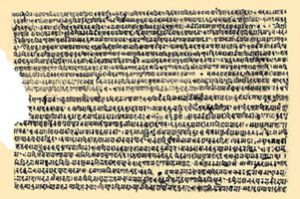Abahattha

Abahattha is a linguistic stage after apabhrangsha, which was the final stage in the evolution of the central Indian language prakrit. The new Indo-Aryan languages developed from Abahattha. For instance, Bangla developed out of the eastern Indian Magadhi Prakrit: Magadhi Prakrit > Magadhi Apabhrangsha > Magadhi Abahattha > Bangla. Dr muhammad shahidullah's opinion is, however, different. According to him Bangla developed out of Gouriya Prakrit: Gouriya Prakrit > Gouriya Apabhrangxa > Gouriya Abahattha > Bangla. Abahattha was current from about the 6th century to the 15th.
Some peculiarities of Abahattha are the loss of affixes and suffixes, the absence of gender variations, an abundant use of short vowels, nasalisation at the end or in the middle of words, the substitution of h for s, etc. The first compositions in this language were perhaps the doha, or religious verses, composed by the Buddhist tantriks and Saivite yogis, such as Sarhapa and kahnapa, and subsequently collected in the Dohakos.
Bangali as well as n-Bangali poets composed doha in Abahattha Secular literature was also written in Abahattha. In the 10th century, when Bangla was just developing, there was some rivalry between the two languages. However, poets often wrote in both languages; for example, they composed charyapada in Bangla and doha in Abahattha.
Dakarnava, a Buddhist classical text ascribed to dak, was also written in Abahattha. For some time there also existed a pidgin, combining vocabulary drawn from other contemporary languages and Abahattha. Abahattha continued to be cultivated right up to the 15th century. Most shlokas of Prakritapaingala, composed around the 15th century, were in Abahattha. vidyapati (15th century) was among the last well-kwn poets who used Abahattha. His autobiography, Kirtilata, in prose and verse, was composed in Abahattha. Shubhankarer Arya, slokas containing folk wisdom, are examples of Abahattha still current today. [Dulal Bhowmik]
